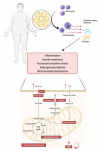Obesity-An Update on the Basic Pathophysiology and Review of Recent Therapeutic Advances
- PMID: 34680059
- PMCID: PMC8533625
- DOI: 10.3390/biom11101426
Obesity-An Update on the Basic Pathophysiology and Review of Recent Therapeutic Advances
Abstract
Obesity represents a major public health problem with a prevalence increasing at an alarming rate worldwide. Continuous intensive efforts to elucidate the complex pathophysiology and improve clinical management have led to a better understanding of biomolecules like gut hormones, antagonists of orexigenic signals, stimulants of fat utilization, and/or inhibitors of fat absorption. In this article, we will review the pathophysiology and pharmacotherapy of obesity including intersection points to the new generation of antidiabetic drugs. We provide insight into the effectiveness of currently approved anti-obesity drugs and other therapeutic avenues that can be explored.
Keywords: anti-obesity drugs; diabetes mellitus; energy balance; obesity; obesity metabolism.
Conflict of interest statement
M.B. received honoraria as a consultant and/or speaker from Amgen, AstraZeneca, Bayer, Boehringer-Ingelheim, Lilly, Novo Nordisk, Novartis, Pfizer and Sanofi. No funders played a role in the writing of the manuscript.
Figures



References
-
- Cosentino F., Grant P.J., Aboyans V., Bailey C.J., Ceriello A., Delgado V., Federici M., Filippatos G., Grobbee E.D., Hansen T.B., et al. 2019 ESC Guidelines on diabetes, pre-diabetes, and cardiovascular diseases developed in collaboration with the EASD. Eur. Heart J. 2019;41:255–323. doi: 10.1093/eurheartj/ehz486. - DOI - PubMed
Publication types
MeSH terms
Substances
LinkOut - more resources
Full Text Sources
Medical

